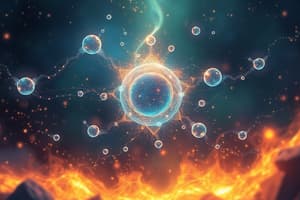Podcast
Questions and Answers
Which of the following is a characteristic of non-metals?
Which of the following is a characteristic of non-metals?
- They are good conductors of electricity.
- They typically have high melting points.
- They usually form basic oxides.
- They are often brittle. (correct)
What is a typical property of metal oxides?
What is a typical property of metal oxides?
- They have low melting points.
- They are usually acidic.
- They are most often gases at 20 °C.
- They are typically basic. (correct)
Which element would likely be classified as a non-metal based on its properties?
Which element would likely be classified as a non-metal based on its properties?
- Element W with a melting point of 1000 °C and acidic oxide.
- Element Z with a melting point of -220 °C and high conductivity.
- Element X with a melting point of 660 °C and high conductivity.
- Element Y with a melting point of 39 °C and 0 conductivity. (correct)
How do metals and non-metals typically react with oxygen?
How do metals and non-metals typically react with oxygen?
Which of the following properties typically does NOT describe a non-metal?
Which of the following properties typically does NOT describe a non-metal?
Which of the following is true about most non-metal oxides?
Which of the following is true about most non-metal oxides?
What describes a typical property of metals?
What describes a typical property of metals?
Which statement most accurately describes a metalloid?
Which statement most accurately describes a metalloid?
Flashcards
Metal properties
Metal properties
Metals generally have high melting points, are good conductors of electricity, and their oxides are typically basic.
Non-metal properties
Non-metal properties
Non-metals typically have low melting points, are poor conductors of electricity, and their oxides are usually acidic.
Metal oxide
Metal oxide
An oxide of a metal, usually solid at room temperature and basic.
Non-metal oxide
Non-metal oxide
Signup and view all the flashcards
Acidic oxide
Acidic oxide
Signup and view all the flashcards
Basic oxide
Basic oxide
Signup and view all the flashcards
Element X
Element X
Signup and view all the flashcards
Element Y
Element Y
Signup and view all the flashcards
Study Notes
Metals and Non-metals
- Metals generally have high melting and boiling points, and are solid at 20°C.
- Many non-metals are gases or low-melting solids at 20°C.
- Some metals are liquid at 20°C (e.g., mercury).
- Metalloids have properties intermediate between metals and non-metals.
- Metalloids are often semiconductors.
Properties of Metals
- Metals are usually good conductors of electricity.
- Metals are often malleable (can be hammered into shapes).
- Metals are often ductile (can be drawn into wires).
- Metals often have a shiny or lustrous appearance.
- Metal oxides are usually basic.
Properties of Non-metals
- Non-metals are usually poor conductors of electricity.
- Non-metals are often brittle.
- Non-metals are often dull in appearance.
- Non-metal oxides are usually acidic.
Metal and Non-metal Reactions
- Many metals react with oxygen to form metal oxides typically solids at 20°C.
- Many non metals react with oxygen to form non-metal oxides.
- Metal oxides tend to be basic when dissolved in water, whereas non-metal oxides tend to be acidic when dissolved in water.
- Acid rain is caused by non-metal oxides dissolving in rain water.
Studying That Suits You
Use AI to generate personalized quizzes and flashcards to suit your learning preferences.




